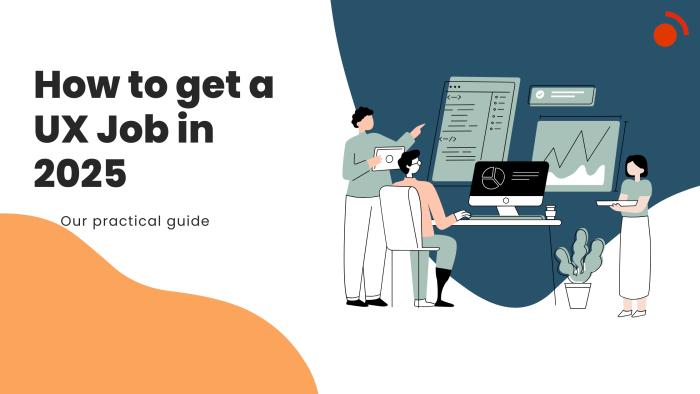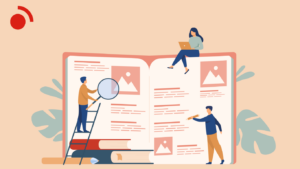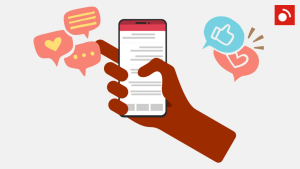How to get a UX Job in 2025: Our practical guide

The UX industry continues to evolve rapidly. In 2025, employers look for more than just technical skills when hiring for a UX job. They want candidates who think critically, communicate clearly, and understand how design impacts both users and business outcomes. If you’re starting your career or changing direction, focus on what truly helps you get hired in today’s UX landscape.
1. Specialize without losing flexibility
UX is a broad field. Few professionals are experts in every part of it and you don’t need to be. Many successful designers go deep in one area like user research, UX writing, accessibility or interface design while still understanding the full design process.
For example, a UX researcher may not specialize in visual design but still understands how insights support interface decisions. A content designer might not prototype full flows but can contribute meaningfully to product strategy.
Identify your strength, whether it’s in wireframing, testing or information architecture and build your profile around it. At the same time, remain curious about related disciplines. A UX junior who understands how to collaborate with developers, marketers and product managers is far more likely to be hired and grow within a team.
2. Create a UX portfolio that tells a clear story
Your UX portfolio is often your first real introduction to hiring managers. In 2025, it’s not enough to showcase beautiful mockups. Hiring managers are interested in your thinking process. Use your case studies to walk them through how you identified user problems, designed solutions and measured their effectiveness.
Use UX case studies to show your thinking. Walk through each phase of the project and explain your decisions clearly. For example:
- What questions did you ask at the start?
- How did you identify the user’s needs?
- What constraints shaped your choices?
- What did you learn and iterate on?
Include two or three well-written UX case studies that follow your process from beginning to end : research, synthesis, ideation, prototyping, testing and iteration. If you worked in a team, explain your role. If something went wrong, share how you handled it.
Even student or personal projects can be valuable if they demonstrate your ability to approach design challenges thoughtfully. Demonstrate the impact of your work by including results such as improved usability, better engagement or positive user feedback..
Where to build your UX portfolio easily
If you’re looking for tools to build your UX portfolio, here are a few that are beginner-friendly:
- Webflow – A great choice if you are looking for a custom, professional look without needing to code
- Adobe Portfolio – Included with Creative Cloud and easy to use
- UXfolio – Specifically built for UX designers with case study templates and built-in structure
- Wix or Squarespace – Intuitive website builders with design flexibility
Whichever platform you choose, focus more on clarity and content than fancy visuals. Employers want to see how you think.
3. Understand the business side of UX
UX design is not just about users, it’s also about helping businesses succeed. Every UX job connects to real business goals, whether that means increasing user retention, reducing support tickets or improving product adoption.
Even if you’re early in your career, show that you think beyond the interface. In your UX case studies or interviews, explain how your work supported business outcomes. Practice answering questions like:
- What was the business challenge behind this project
- How did your design support that goal
- What trade-offs did you need to make
Speaking the language of business builds trust with hiring teams and shows you understand the full context of UX work.
4. Learn tools but focus on how you think
Familiarity with tools like Figma, Notion, Miro, Maze and Adobe XD is expected for any modern UX job. But mastering tools is not what defines a great designer. What matters more is how you approach problems and communicate ideas :
- Can you explore different solutions and explain your reasoning ?
- Can you sketch ideas on paper or run a whiteboard session ?
- Can you collaborate with others and adapt based on feedback ?
New tools will always emerge. Strong UX designers know how to think independently of any one platform.
5. Stay current with AI without losing human insight
AI is now part of everyday UX practice, and its influence will only grow. Designers use AI to cluster research insights, generate interface drafts, write content and more.
But AI cannot replace thoughtful design. As AI continues to shape the tools we use, human qualities like empathy, ethics and contextual judgment become even more essential. Designers must still ask the right questions, prioritize accessibility and build experiences that are inclusive and meaningful.
Explore AI tools as part of your process but always apply your own thinking. Treat them as collaborators, not shortcuts.
6. Communication and collaboration matter more than ever
Most UX jobs happen within teams. You’ll work with developers, stakeholders, researchers and often users. Your ability to collaborate and communicate is just as important as your design skills.
You do not need to be a polished public speaker, but you do need to express your thinking clearly. Whether you’re walking through a wireframe, giving feedback or running a user test, people need to understand your decisions.
Strong communication also includes active listening. Ask thoughtful questions, welcome feedback, and stay open to other perspectives. These are the soft skills that make a UX junior stand out.
To improve your portfolio, practice presenting it to friends or mentors. Join design communities. Take part in critiques. Like design itself, communication improves with iteration.
7. How the CAWEB Master adds value
For aspiring UX designers looking for a strong academic foundation and real-world experience, the CAWEB Master’s program at the University of Strasbourg offers a uniquely well-rounded path. The program blends UX design with courses in web development, content strategy, accessibility, localization and project management.
This interdisciplinary approach gives students the flexibility to work across industries and international markets. You learn not only how to create great digital experiences, but also how to manage projects, communicate effectively and work across cultures and languages.
CAWEB students often gain hands-on experience through real client projects, multilingual collaboration, and tool-based training.The program emphasizes adaptability, which is an essential quality for anyone navigating the fast-changing world of UX.
If you’re considering studying UX in Europe and want a mix of practical training, global perspective and creative freedom, CAWEB is a strong option worth exploring.
Final thoughts
Getting hired in UX in 2025 requires more than knowing the latest tools or following trends. You need to understand people, solve meaningful problems, and communicate your process clearly. Employers want designers who are thoughtful, collaborative and ready to grow with their teams.
Whether you’re just starting or shifting into UX from another field, your mindset matters. Build a strong UX portfolio with focused case studies. Learn the language of business and design. Stay curious, keep learning and don’t be afraid to show how you think.
If you take the time to prepare well, explore the right opportunities, and bring a clear perspective to your work, you will be ready to get that UX job in 2025 and thrive in it.
Written by Alix Dubon
Other articles
-

Discover our online Master in digital communication
-

Emerging Technologies : Exploring New Opportunities for Immersive Art Experiences
-

CAWEB Master’s Adds New Intercultural Communication Course
-

An Introduction to Usability Testing Methods
-

The Future of Remote Work: Navigating a Hybrid Workforce Landscape


